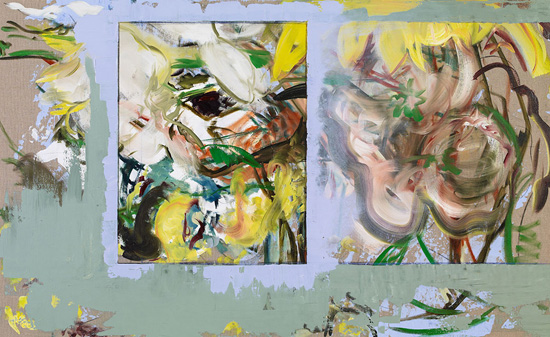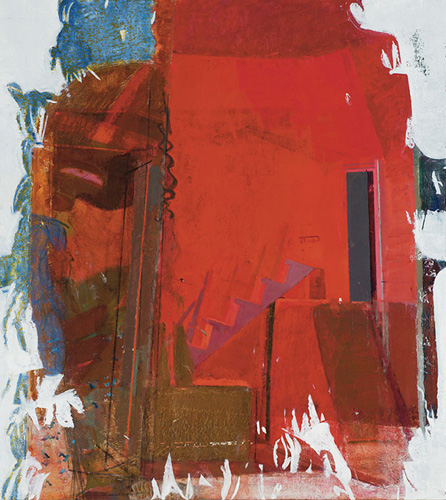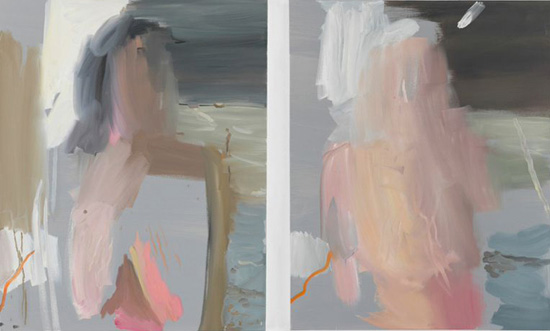This piece is drawn from the work of the artists, writers, art historians, and critics footnoted. The collected phrases are plucked from their writing, and, in some cases, slightly altered to follow the cadence or tense of Gil Scott-Heron’s “The Revolution Will Not Be Televised.”
Cy Twombly. Camino Real (II), 2010. Acrylic on wood panel
99 3/8 x 72 7/8 inches. Courtesy Gagosian Gallery. © Cy Twombly Foundation
The Revolution Will Be Painted
Anne Sherwood Pundyk
December 2015
THE REVOLUTION WILL BE PAINTED
The revolution will be painted.
 Anne Sherwood Pundyk. Recognize Me, 2012
Anne Sherwood Pundyk. Recognize Me, 2012
Oil and acrylic on linen; 40 x 65 inches. Courtesy of the artist © Anne Sherwood Pundyk
Painting will no longer create space as a theatre;
it will give space itself a theatre. (5)
The paint will meet the surface sensuously,
In a broad, flat engagement of the palm, by fingertip daubs,
and through varieties of clawing and caressing. (6)
Painting will always tremble, but very precisely. (7)
There will be no difference in the world between
planning airily away from the canvas
and actually taking your brush and making the first mark. (8)
The revolution will be painted.
You will become aware of small transformations. (9)
Precision and incoherence will be improvised with dazzling speed
into chattering, chanting, and excoriating fields. (10)
Painting will put us in touch with what is ungovernable in the body. (11)
Each line will be the actual experience of its own innate history. (12)
The brushstrokes will lack consistency and be loosely disposed
over the surface of the canvas. (13)
Every element will have a rising, hovering, or sagging weight,
achieved by finesse with relative densities
and by a supreme sense of color. (14)
The paint will be overtaken by an extraordinary density
securing a complete interlocking of image and paint. (15)
The revolution will be painted.
 Sangram Majumdar. Unbuilt to Suit, 2013
Sangram Majumdar. Unbuilt to Suit, 2013
Oil on linen; 72 x 64 inches. Courtesy of the artist. © Sangram Majumdar
The brushwork will no longer function as a mere record of
perception,
but as a shorthand equivalent for perceptions of the tangible world. (16)
Painting will be more tangible in its articulation of nature. (17)
The string of images layered within each painting will
begin to communicate the inaudible truth of the inner self. (18)
The naked or otherwise vulnerable bodies of women
will read as retribution for centuries of less attuned representations by men
and also for the supposed neutrality of abstraction. (19)
The revolution will be painted.
Situated near the edge of visibility,
painting will exude a stillness and lapse into immobility. (20)
The conditions of seeing will come into focus. (21)
Painting will be in the present tense. (22)
The stained or brush-worked canvases will be
lurid in subject or color. (23)
A painting will be unexpectedly altered in the process of its viewing. (24)
You will become aware of the paradoxes of symmetry. (25)
A painting will never know where else it might go,
and will be incapable of closing down the possibility of an exit from
wherever it happens to be right now. (26)
The revolution will be painted.
 Brad Jones (an ongoing collaboration by Brandi Twilley and Jennifer Rubell). Cord (left side), 2014
Brad Jones (an ongoing collaboration by Brandi Twilley and Jennifer Rubell). Cord (left side), 2014
Oil on canvas, diptych; 36 x 24 inches. Courtesy Sargent’s Daughters Gallery. © Brad Jones
The slippery bliss of the paint will be revealed in slipping glimpses. (27)
In a new form, paintings will house the sequence of recognized moments,
ready for reception and interpretation. (28)
The feeling in painting will no longer be a taste for horror,
it will be pity, a pity for flesh. (29)
The body will be the source and destination of sensation perceived and painted. (30)
A field of seemingly incongruous gestures will come
together to form one distinct image. (31)
The outpouring of fervid color will be seen as a resurgence
of an expansive levitation that will deny the heaviness of physical concern. (32)
The revolution will be painted.
Each layer will remain a sketch, often visible through the one that covers it. (33)
Painting will create a whole from parts
in an unsettled and unsettling relationship. (34)
The resonance between body and landscape will reverberate
thorough choices of browns, pinks, reds, and whites. (35)
Painting will be irresponsible to gravity. (36)
A gestured brush drawing on top of painted forms
will define and relocate specific contours. (37)
The painting will be waiting to be recognized. (38)
The painting will bear the marks of its making. (39)
The revolution will be painted.
1. Variation on lyrics from Gil Scott-Heron’s “The Revolution Will Not Be Televised,” Flying Dutchman, 1971, B-Side 7” single vinyl record.
2. Anne Coffin Hanson, “Manet’s Pictorial Language,” in Manet: 1832–1883, ed. John P. O’Neill (New York: The Metropolitan Museum of Art, 1983), 21.
3. Anne Sherwood Pundyk, Barry Schwabsky, and Kara L. Rooney, stadia: Anne Sherwood Pundyk (New York: Blurb, 2014), 50.
4. Frank Stella, Working Space (Cambridge, MA: Harvard University Press, 1986), 60.
5. Clement Greenberg, “Cezanne,” in Art and Culture (Boston: Beacon Press, 1961), 54.
6. Kirk Varnedoe, Cy Twombly: A Retrospective (New York: Museum of Modern Art, 1994), 35.
7. John Elderfield, “Space to Paint,” in De Kooning: A Retrospective (New York: Museum of Modern Art, 2011), 14.
8. Virginia Woolf, To the Lighthouse (London: Harcourt, 1927), 161.
9. Robert Evrén, “Dispatch from the Tropic of Flesh,” in Cecily Brown (New York: Gagosian Gallery, 2000), 10.
10. Roberta Smith, “Collisions on Canvas That Still Make Noise: Jean-Michel Basquiat,”The New York Times, March 11, 2005.
11. John Kelsey, “To Be the Knife: Notes on Rita Ackermann,” in Rita Ackermann (New York: Skira Rizzoli, 2010), 71.
12. Cy Twombly, “Documenti di una nuova figurazione: Toti Scialoja, Gastone Novelli, Pierre Alechinsky, Achille Perilli, Cy Twombly,” L’Esperienza moderna, no. 2 (August–September 1957): p.32, quoted in Varnedoe, Cy Twombly, 27.
13. Hanson, “Manet’s Pictorial Language,” 25.
14. Peter Schjeldahl, “Tough Love: Resurrecting Joan Mitchell,” New Yorker, July 15, 2002.
15. Gilles Deleuze, Francis Bacon: The Logic of Sensation (Minneapolis: University of Minnesota Press, 2003), 17.
16. Hanson, “Manet’s Pictorial Language,” 25.
17. Greenberg, “Cezanne,” 51.
18. Pundyk and others, stadia, 44.
19. Roberta Smith, “The Body Politic: Gorgeous and Grotesque: ‘Marlene Dumas: Measuring Your Own Grave,’” New York Times, December 11, 2008.
20. Evrén, “Tropic of Flesh,” 10.
21. Ibid.
22. Anne Sherwood Pundyk, “Bushwick Art Crit Group” (lecture, Fireproof Art Gallery, Brooklyn, NY, October 14, 2014).
23. Smith, “Body Politic.”
24. Elderfield, “Space to Paint,” 16.
25. Evrén, “Tropic of Flesh,” 10.
26. Bonnie Clearwater, “Rita Ackermann,” in Rita Ackermann, (New York: Skira Rizzoli, 2010), 21.
27. Elderfield, “Space to Paint,” 37.
28. Pundyk and others, stadia, 44.
29. Deleuze, Francis Bacon, xxix.
30. Pundyk and others, stadia, 46.
31. Michael Auping, “A Long View,” in Howard Hodgkin: Paintings (Fort Worth, TX: Modern Art Museum of Fort Worth, 1995), 20.
32. Varnedoe, Cy Twombly, 35.
33. Hanson, “Manet’s Pictorial Language,” 27.
34. Elderfield, “Space to Paint,” 16.
35. Varnedoe, Cy Twombly, 35.
36. Ibid.
37. Hanson, “Manet’s Pictorial Language,” 26.
38. Auping, “A Long View,” 18.
39. Hanson, “Manet’s Pictorial Language,” 28.
Dec 22, 2014
Revolution Part II “The Revolution Will Be Painted” Revisited

Very affirming; affirming of the power of things like nuance and subtlety, qualities left out of so many aspects of life.